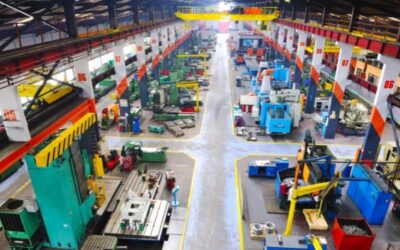As the pandemic comes to an end, manufacturing businesses have faced many issues. On top of inflation, finding employees and continued supply chain issues, another year of preparing for the potential tax burden is upon each business. This article will discuss tax-saving opportunities and credits applicable to the manufacturing industry to consider when consulting with your tax advisor.
Important Tax Saving Opportunities for Manufacturers
As we approach another tax season full of various filing requirements, businesses need to know any tax savings opportunities that may arise from the previous year’s operations. Though many tax planning instances are on a case by case basis, below are a few common ones that may apply to a typical manufacturing company:
- Net Operating Losses Carrybacks
The CARES Act has expired when it comes to the ability to carryback Net Operating Losses (NOLs) to offset taxes paid in the previous five years. If a NOL occurred in 2020, then it can be carried back to offset taxes paid in any of the last five years. Upon election in the individual’s tax return, 2018-2020 NOLs can be carried forward to offset future taxable income. If a NOL occurred in the tax year 2021, moving forward, it is required to be carreid forward to future years. - Cost Segregation Study
These studies can be a valuable tax-saving strategy for manufacturing companies. A cost segregation study is used to identify all costs in a manufacturing facility that has a life of less than 39 years. If the operating company does not hold the facility, a study can still apply to a related party holding company. - Tax Accounting Methods
An election can be made in the current year or prior tax returns (with an amendment) to make an accounting change. Both require consent from the Internal Revenue Service requested via Form 3115. A change regarding previous years may require a prior period adjustment based on the type of accounting change. In general, companies that fall under average gross receipts of $27 million for 2022 are considered a small business and will have the flexibility to make accounting changes. Companies that are above this threshold have less restrictions and are subject to more set accounting rules.
The two main tax planning goals to achieve in an accounting change are:- Income deferral
Common types of income deferral include advanced payments, deposits, and deferred revenue, long-term contracts, installment sales, and like-kind exchanges - Expense acceleration
Common types of expense acceleration include treatment of prepaid expenses, software development costs, fixed assets, and other opportunities
- Income deferral
It is important to continuously examine how a manufacturing company is accounting for income and expenses for tax purposes. It is crucial to weigh the benefits and costs of changing accounting treatment.
Tax Credits for Manufacturers
Many activities manufacturing companies participate in may qualify them for tax credits. Tax credits are most commonly derived from operations, employees, and facilities. It is important to understand each business aspect to know if eligible for the many tax credit opportunities. Here are the most common tax credits that may apply to a manufacturing business.
Research and Development (R&D) Tax Credit
This federal tax credit was introduced in 1981. The credit is an incentive for operating businesses to invest in research and development activities. In the manufacturing industry, these costs are most often used to increase growth and competitiveness. The maximum credit allowed is 13% of eligible expenses spent on new and improved products and processes.
The costs must meet the following categories of new or improved to the company. These include technological in nature, elimination of uncertainty, and must go through a process of experimentation. The most common activities that manufacturing companies participate in that may be eligible for the credit are:
- Sales time – quoting, job requirements
- Design meetings – staff working together towards innovation
- Product design – blank layouts, toolmaking, documentation, quality checks, trial runs
- Engineering
- Shipping
Note: Manufacturing activities that improve an existing product or process may qualify for this tax credit.
Payroll Tax Credits & Deferrals
The CARES Act provided an Employee Retention Credit (ERC). The ERC is a refundable payroll tax credit for 50% of wages paid to employees during the COVID-19 crisis. The credit applies to wages paid after March 12, 2020, and before September 30, 2021 (3rd quarter 2021).
The maximum amount of wages eligible for the credit is $10,000 per employee, which results in a maximum credit for each employee of $5,000 for 2020 and $7,000 for 2021. The wages also need to be considerd “qualified”. Qualified wages are based on the average number of full-time employees that exist in the company and also must meet the definition under the code section(s) 3121(a) and 3231( e).
An eligible employer must also meet one of two tests:
- fully or partially suspended from operations during the period above due to orders from an appropriate governmental authority limiting commerce, travel, or group meetings (for commercial, social, religious, or other purposes) due to COVID-19; or
- Experience a significant decline in gross receipts during the calendar quarter when comparing to the same quarter in 2019.
Note: Qualified wages are not eligible for the credit to the extent they were paid by Payroll Protection Program (PPP) loan funds.
Tax Deductions for Manufacturers
Through the different tax acts in the previous 5 years, many deductions have either been altered or eliminated. Below are some of the most common deductions based on the current tax environment:
Qualified Business Income (QBI) Deduction
Qualified Business Income from pass-through entities (sole proprietorships, partnership, or S-corporations) are generally eligible. The deduction is maximized at 20% of qualified business income. This deduction can be limited depending if the business operates as a specified service or trade business. If the individual’s taxable income exceeds an income threshold, the deduction is also subject to additional limitations.
The three general categories that determine the deduction are the business’s qualified business income, W-2 wages, and the business’s qualified property’s unadjusted basis. Any one of these items can be analyzed before year-end to maximize the deduction through proper tax planning.
Accelerated Depreciation
Section 179 is eligible for up to over $1.08 million of qualifying property placed in service in the tax year. Note: Minnesota recently conformed to the federal treatment of section 179 for the years 2020 and after.
Bonus depreciation for 100% of qualified property is eligible through 2022. From years 2023 – 2027, the deduction will reduce until no longer available.
The CARES Act provided a technical correction from Tax Reform in December 2017. Qualified Improvement Property (QIP) is now a 15-year, bonus depreciation eligible property. QIP consists of interior, non-structural improvements to commercial buildings added after the buildings were initially placed in service.
Passthrough Entity Tax
Starting in tax year 2021, passthrough entities (S Corporations or partnerships) are eligible to deduct the state taxes related to their business income on the business. The current individual state and local tax (SALT) deduction limit is $10,000. By paying the state taxes related to the business income on the business tax return, the $10,000 limitation can be avoided. In return, the owners receive a credit for taxes paid on their individual state tax returns.
Be aware that each state rules may be slightly different and not all states currently participate.
Section 179D Energy-Efficient Commercial Property Deduction
This deduction is eligible for manufacturing companies that directly or indirectly own a newly constructed building or improved an existing building. To claim the deduction, the new building or improvements must invest in one of the three energy-efficient categories:
- Lighting – construction or improvements to building lights for energy efficiency
- HVAC – relating to energy-efficient systems
- Building Envelope – energy-efficient construction or improvements to walls, floors, roofs, fenestrations, and doors
The calculation of the deduction is based on the square footage of a new building or improvements. In 2021, the deduction provides for up to $1.88 per square foot of the energy-efficient space. Each category above can obtain a $0.63 deduction. To qualify for this deduction, a building must be certified by a qualified third-party and compared to ASHRAE Standards. These numbers will likely be indexed for inflation for 2022.
OTHER OPPORTUNITIES FOR CONSIDERATION
There are several other opportunities for a manufacturing business to consider. Based on some common business themes relating to the manufacturing industry, below are a few additional items to consider when looking for savings in the coming year:
- Review Terms of Current Contracts
- Banks – Line of credit or other long-term debt agreements. Interest rates have decreased in 2020. If you have a minimum interest rate on any variable contracts, it is a good idea to review and refinance. Look to extend the length of renewal. A longer renewal period can help freeze pricing and provide assurance to a bank to maintain the relationship. Many companies make the mistake of negotiating yearly, which leads to lower prices, but could risk damaging the relationship with the bank.
- Vendors – Similar to banks, look to renegotiate terms with your vendors. Items to focus on can be discounts for early payments, extended payment terms, or payment allowance with a credit card.
- Improve Inventory Management – Proper inventory management, especially in a manufacturing company, is a great way to improve cash flow. Removing excess or slow-moving inventory can be a quick way to reduce waste and generate cash flow. Initial fees may be incurred, but the long-term cash savings can outweigh the costs.
Manufacturing companies should also analyze the amount of inventory needed for operations. Reducing the overall value in inventory may result in a simple improvement in cash flow. Also, businesses should consider updating purchasing procedures or any other inventory processes. - Sell Assets – Review each fixed asset on an annual or more frequent occurrence to determine if any non-productive assets can be sold. Non-productive are commonly old assets that have not been used for a while or items no longer required by current operations.
Are you confident you are doing everything to minimize taxes for your manufacturing business?
As you push your shop floor to run faster, leaner, and more efficiently, you need people who can help you apply the same principles to your business office. Schedule a consultation with a Smith Schafer Manufacturing Expert to determine tax-saving opportunities for your company. We work with approximately 100 Minnesota manufacturing companies helping them grow with accounting, tax, and consulting solutions.



